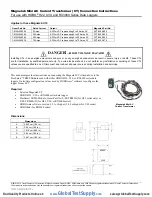
Remote Learning Function
By pressing the teach-in button PTx, compatible
receivers, which are programmed with RTS43,
can also be set to learning mode or delete mode
while installed.
The transmitter is live. Do not touch any
live parts (terminal, transformer) when
pressing the PTx button.
To start the remote learning, the connected switch
elements must be open and a button must be con-
nected.
The jumper serves exclusively to select which
transmission code the remote learning function
should trigger.
Jumper Position 1-2
Jumper Position 2-3
S1-->Transm. code
A1
S2-->Transm. code
B1
S1-->Transm. code
A1
S2-->Transm. cod
A2
For more information please refer to the opera-
ting manual for the respective receiver.
Disposal
Waste electrical products may not be dispo-
sed of with household waste!
Dispose of the waste product at a
designated collection point for electronic
waste or via your specialist retailer.
Dispose of the packaging material in the
recycling containers for cardboard, paper
and plastics.
Warrenty
During the warranty period, we undertake to rec-
tify free of charge by repair or replacement any
product defects arising from production or mate-
rial faults.
Any unauthorised tampering with, or modifications
to, the product shall render this warranty null and
void
Conformity
ELDAT GmbH hereby declares that the radio
equipment type RTS43 is in compliance with the
Directive 2014/53/EU.
The full text of the EU declaration of conformity
can be obtained at the following internet address:
www.eldat.de
Customer Service
If, despite correct handling, faults or malfunctions
occur or in case of damage, please contact your
retailer or the manufacturer.
ELDAT GmbH
Im Gewerbepark 14
15711 Königs Wusterhausen
Germany
Phone: + 49 (0) 33 75 / 90 37-310
Fax:
+ 49 (0) 33 75 / 90 37-90
Internet: www.eldat.de
E-Mail: [email protected]
RTS43E5002A01 230 V
N
230 V
L
N
230 V
L
RTS43E5002A02 12-24 V
12-24 V
AC/DC
IN1 IN2
+
+
-
-
O
12-24 V
O
~
IN1 IN2
+ -
O
12-24 V
O
12-24 V
AC/DC
+-
~
UM140654 01
18 DE
and S2 must always be connected with the poten-
tial applied to IN1!
oth “O” outputs are internally bridged with IN1 and
can therefore be used as the source.
Connecting electrical devices to
the output terminals (O) is not per-
mitted!
The output terminals (O) are ex-
clusively intended for connecting
the S1 and S2 switch inputs!
The three L terminals are internally bridged and
can be used to connect S1 and S2.
Connecting electrical devices to
the L terminals is not permitted!
The bridged L terminals are ex-
clusively intended for connecting
the S1 and S2 switch inputs!
Each L, with the same reference potential (N) as
the power supply, can be used to connect S1 and
S2.
L
:
Power supply, 230 V AC
N
:
Power supply, 230 V AC
S1
:
Switch input 1
S2
:
Switch input 2
IN1
:
Power supply
AC: 12-24 V
DC: + 12-24 V
IN2
:
Power supply
AC: 12-24 V
DC: - 12-24 V
O
:
Output
S1
:
Switch input 1
S2
:
Switch input 2
Connection Examples
Select Mode
BUTTON Mode
Jumper
MODE
in position 1-2
The transmitter sends for as long as a button
is pressed, but for a maximum of 36 seconds.
Button 1
: Input S1 Transmission code
A1
Button 2
:
Input S2 Transmission code
B1
SWITCH mode
Jumper
MODE
in position 2-3
hen the switch changes state, the transmit-
ter sends a switching pulse lasting approx.
0.5 seconds.
Switch 1: Input S1
Close switch: Transmission Code
A1
Open switch: Transmission Code
B1
Switch 2: Input S2
Close switch: Transmission Code
A2
Open switch: Transmission Code
B2
1
3
2
Mode
1
3
2
Mode




















